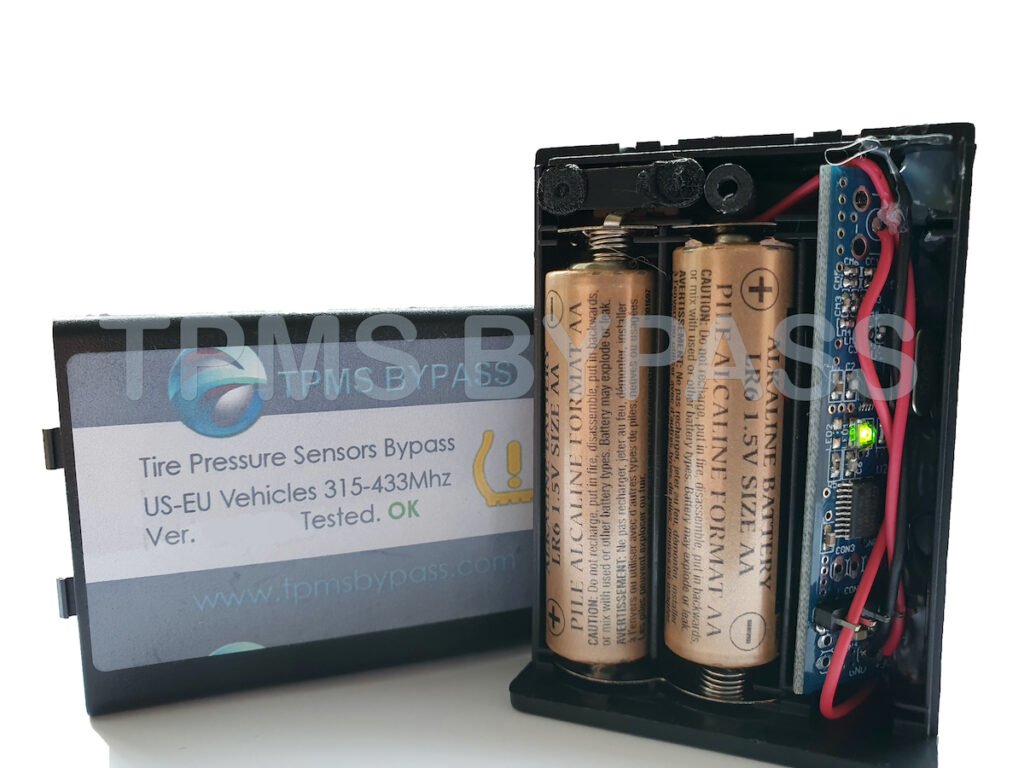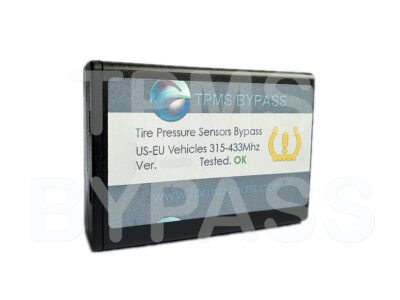Description
Annoying TPMS Light on a Dashboard because Tire Sensor(s) just failed?
Do you want to mount new summer/winter wheels without TPMS sensors?
Garage or Dealer are overcharging for TPMS sensors and labour?
Introducing the Worlds First TPMS BYPASS – Low Tire Pressure Light Repair Emulator
The device we sell is a very simple and a lifelong solution to the annoying dash light indicator. It’s designed by our engineers and manufactured according to the highest standards. Ideal for any tyres winter/summer with or without TPMS sensors. TPMS Bypass consists of a small box which can be discreetly placed usually at the front of the vehicle.
- Requires 2 x AA batteries only!
- Connects by wireless signal!
- Ideal for Winter and Summer tires!
- No need to replace faulty TPMS sensors!
- No need to take your car to the garage or dealer!
- Bypass all wheels with or without TPMS Sensors!
- Detailed Installation Instructions Included!
With step by step instructions supplied our TPMS Bypass will take less than 15 min to connect and BYPASS TPMS SYSTEM/SENSORS in the vehicle and you’re ready to GO!
What is excellent that this Low Tire Pressure Light Repair Bypass box works by a wireless signal and not a hardwiring. Additionally, once our box is removed from the vehicle TPMS system reverts back to it’s original preset. Our device is also suitable for vehicle Annual Tests such as MOT, NCT or any other.
COMPATIBLE with US LINCOLN variants
MARK LT 2007 – 2008
MKS 2009 – 2013
MKT 2010 – 2011
MKX 2007 – 2011
MKZ 2007 – 2011
NAVIGATOR 2007 – 2011
TOWN CAR 2006 – 2011
CHECK TIRE PRESSURE: Check your vehicle tire pressure located at the driver’s side doorjamb (called the “B-pillar”). If manufacturer’s recommended pressure is higher than 45 psi or 3.1 bar then make sure to leave a checkout note that HP – Higher Pressure box is needed.
- 1 x TPMS – Tire Pressure Monitoring System BYPASS
- 1 x Detailed Fitting Instructions
Compatibility Pre-Check!
This compatibility pre-check is suitable for the majority of Ford vehicles.
Vehicles with a PUSH BUTTON ignition start, please follow the steps below.
1. With vehicle off, press and release the brake pedal.
2. Press, and hold, the START button until chime sounds.
3. Power off by pushing the button 1 time.
4. Press, and hold, the START button until chime sounds.
5. Power off by pushing the button 1 time.
6. Press, and hold, the START button until chime sounds.
7. Press and release the brake pedal.
8. Power OFF by pushing the button 1 time.
9. Press, and hold, the START button until chime sounds.
10. Power OFF by pushing the button 1 time.
11. Press, and hold, the START button until chime sounds.
12. Power off by pushing the button 1 time.
13. Press, and hold, the START button until chime sounds.
The car horn should sound once meaning that your car is compatible with our device!
Vehicles with an IGNITION KEY, please follow the steps below.
1. Place the key in the ignition in the off position (do not turn the key)
2. Place foot on the brake for 2 seconds and remove
3. Turn the ignition key to the second position so that the dash lights are illuminated. Do not start the engine.
4. Return the key to the off position.
5. Turn the ignition key to the second position so that the dash lights are illuminated. Do not start the engine.
6. Return the key to the off position.
7. Turn the ignition key to the second position so that the dash lights are illuminated. Do not start the engine.
8. Place foot on the brake for 2 seconds and remove.
9. Return the key to the off position.
10. Turn the ignition key to the second position so that the dash lights are illuminated. Do not start the engine.
11. Return the key to the off position.
12. Turn the ignition key to the second position so that the dash lights are illuminated. Do not start the engine.
13. Return the key to the off position
14. Turn the ignition key to the second position so that the dash lights are illuminated. Do not start the engine.
The car horn should sound once meaning that your car is compatible with our device!
Buy With Confidence
- Highly skilled engineering Team with 10+ Years’ experience in automotive sensing particular in Low Tire Pressure Light Repair Emulators.
- Our Professional Staff is skilled and cover all aspects of Design to Shipping including prompt customer service.
- Patented technology revolutionary device, Researched and developed in-house, using the very latest design Simulation tools and testers.
- This solution is designed as non-invasive. It will switch OFF that annoying TPMS light Without modifying your Vehicle in any way. Simply switch it off and your vehicle is no longer using this technology. Unlike other solutions that re-write the ECU which is a permanent modification.
- 60 – Days Money Back Guarantee no questions asked. If you don’t like the product or just change your mind.
- Fast and tracked World Wide Shipping usually with 1-2 weeks delivery timeframe.
- The Device comes with 5-year Warranty and detailed installation instructions.
Tyre Pressure Monitoring Systems
An increasing number of vehicle makes and models are fitted with TPMS – tyre pressure monitoring systems. Most new vehicles manufactured since 2012(EU) and 2005(US) have TPMS integrated as standard. A sensor valve in each tyre monitors tyre pressures and reports low pressures or tyre pressure imbalances to the driver via the dashboard display.
Battery exhaustion a looming issue with TPMS sensor units
One of the most common TPMS sensor issues are batteries failing within the pressure sensors. Typically, the batteries will start to decline rapidly after 5 years of operation and such batteries cannot be replaced. Furthermore, when one TPMS battery fails the remaining wheels batteries will soon fail. This is because the batteries have been fitted to the sensors about the same time. In addition to this, TPMS sensor stems can also become corroded over time as they are open to the elements and take on everything the road as to throws at them.
Did You Know?
Faulty TPMS sensors can now result in an immediate MOT/NCT or any other Vehicle test failure. In UK ss of 1st January 2015, vehicles manufactured from 2012 displaying TPMS warning light on the dashboard will fail its MOT test. Car dealers want you to bring your car to them to replace the TPMS sensors. Depending on your dealership, expect to spend between £120-£210/$150-$250 PER WHEEL to have them replaced and coded to the OBD (onboard diagnostics). Only for a fraction of a cost, this device will Bypass TPMS system in your vehicle! No need to take your car to the dealer or garage! With step by step instructions supplied Low Tire Pressure Light Repair Emulator will take less than 15 min to connect and BYPASS TPMS SYSTEM/SENSORS in the vehicle and you’re ready to GO!
You Are the Best Tire Pressure Monitoring System
Rely on TPMS to warn you only of a puncture or an active air leak. It’s your responsibility as a driver to check your tire pressures monthly, or at least have them checked by someone else. On new cars, the automaker’s recommended pressure is on a placard on the driver’s doorjamb. On older cars, it can be on the trunk lid. It is not on the tire.





Reviews
There are no reviews yet.